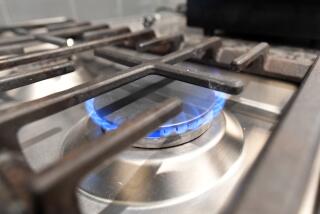A cook’s dream appliance? It’s not a fancy stove
- Share via
I’d WAITED LONG ENOUGH. After more than 10 years in my current house, I finally made the leap: I bought a hood vent for my stove. Now I find myself wandering out into the kitchen at night, stroking its satiny housing and marveling at the way the street lights reflect off the stainless steel. Sometimes I’ll even turn it on, even if I haven’t cooked anything.
Most of you are probably wondering what could be so special about a fan. That’s because almost every house built in the last 40 years comes with at least some sort of feeble ventilation system to clear cooking odors from the kitchen. Apparently this was not so when my house was built in the mid-1930s. The only venting that came with my kitchen was an odd concave cutout in the ceiling with a pipe attached to it. I guess they hoped cooking smoke and smells would find their way out of the house on their own.
Most of them didn’t. Which meant that kitchen odors tended to linger. It’s nice and homey to smell roast chicken the night you cook it. It’s less so the next morning. And after three days, it’s enough to make you want to eat out and never cook again. That’s to say nothing of fish.
When you’re in the kitchen as much as I am, this can turn into an obsession. I swear some nights I couldn’t get to sleep, convinced that I was smelling yesterday’s dinner in my pillow.
Finally, I had had enough. I decided that this would be my year of the hood vent. With typical compulsiveness, I began my research. I talked to kitchen architects, shopped at home stores, went online to kitchen remodeling Web sites and basically spent a couple of months harassing anyone who might have some information.
On the surface, there’s really not that much to a hood vent: It’s a fan attached to a metal housing that connects to a hole in the roof. But to the true obsessive, even the simplest of things demands thorough investigation. I quickly immersed myself in the mysteries of CFM and sones.
To the ventilation cognoscenti, CFM means cubic feet per minute; it’s the measure of a fan’s pulling power. Most standard vents -- the kind you can pick up at Home Depot for $100 or less -- will pull a couple hundred CFM. High-end vents pull at least 400 CFM and the cheapest are around $500. The most powerful custom units will pull 1,500 CFM, but for most practical purposes the power tops out at 800 to 1,000. For these you’ll pay at least $1,500. Some of the big names include Vent-A-Hood, Best by Broan and industrial stove makers DCS and Viking. The vent I settled on, a Zephyr Venezia, will pull more than 700 CFM. It cost about $1,200, installed (more, incidentally, than I spent on either my Sears refrigerator or my old O’Keefe & Merritt stove).
Almost as important as the CFM are the sones. This is a measure of the noise a fan generates. You may have guessed that the more powerful the fan, the noisier it will be. One of the high-CFM vents I tried out made me think I was in the landing pattern at LAX.
Most acceptable vents operate at around six sones (one sone is usually described as being the noise level of a quiet refrigerator running). The better machines, like mine, go down to three sones when operating on lower power. I haven’t actually measured it, but my Zephyr is pretty quiet, though when I turn it all the way up it does make a reassuringly authoritative roar as it clears the air.
And it works like a dream. These days when I roast a chicken, the only thing left afterward is a wishbone and a memory.
More to Read
Eat your way across L.A.
Get our weekly Tasting Notes newsletter for reviews, news and more.
You may occasionally receive promotional content from the Los Angeles Times.











